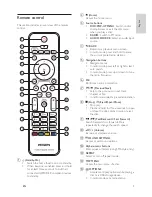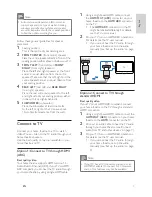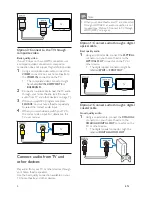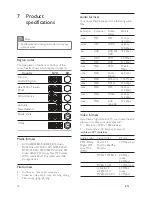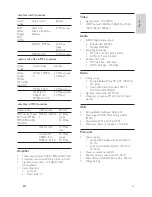
7
English
EN
Note
•
Surround sound depends on factors such as
room shape and size, type of wall and ceiling,
windows and re
fl
ective surfaces, and speaker
acoustics. Experiment with the speaker positions
to
fi
nd the optimum setting for you.
Follow these general guidelines for speaker
placement.
1
Seating position:
This is the centre of your listening area.
2
FRONT CENTER
(front centre) speaker:
Place the centre speaker directly in front of the
seating position, either above or below your TV.
3
FRONT LEFT
(front left) and
FRONT
RIGHT
(front right) speakers:
Place the left and right speakers at the front,
and at an equal distance from the centre
speaker. Make sure that the left, right and the
centre speakers are at an equal distance from
your seating position.
4
REAR LEFT
(rear left) and
REAR RIGHT
(rear right) speakers:
Place the rear surround speakers to the left
and right side of your seating position, either
in line with it or slightly behind it.
5
SUBWOOFER
(subwoofer):
Place the subwoofer at least one metre
to the left or right of the TV. Leave about
10-centimetres clearance from the wall.
Connect to TV
Connect your home theatre to a TV to watch
videos. You can listen to the TV audio through your
home theatre speakers.
Use the best quality connection available on your
home theatre and TV.
Option 1: Connect to TV through HDMI
(ARC)
Best quality video
Your home theatre supports HDMI version 1.4 -
Audio Return Channel (ARC). If your TV is HDMI
ARC compliant, you can hear the TV audio through
your home theatre by using a single HDMI cable.
1
Using a High-Speed HDMI cable, connect
the
HDMI OUT (ARC)
connector on your
home theatre to the
HDMI ARC
connector
on the TV.
•
The
HDMI ARC
connector on the TV
might be labelled differently. For details,
see the TV user manual.
2
On your TV, turn on HDMI-CEC operations.
For details, see the TV user manual.
•
If you cannot hear the TV audio through
your home theatre, set up the audio
manually (see 'Set up the audio' on page
9 ) .
Option 2: Connect to TV through
standard HDMI
Best quality video
If your TV is not HDMI ARC-compliant, connect
your home theatre to the TV through a standard
HDMI connection.
1
Using a High-Speed HDMI cable, connect the
HDMI OUT (ARC)
connector on your home
theatre to the
HDMI
connector on the TV.
2
Connect an audio cable to hear the TV audio
through your home theatre (see 'Connect
audio from TV and other devices' on page 7 ) .
3
On your TV, turn on HDMI-CEC operations.
For details, see the TV user manual.
•
If you cannot hear the TV audio through
your home theatre, set up the audio
manually (see 'Set up the audio' on page
9 ) .
Note
•
If your TV has a DVI connector, you can use an
HDMI/DVI adapter to connect to TV. However,
some of the features may not be available.
TV
Summary of Contents for HTS3541
Page 1: ...HTS3541 Register your product and get support at www philips com welcome ...
Page 2: ......
Page 30: ...28 EN ...
Page 60: ...30 ES ...
Page 61: ...Language Code ...
Page 62: ... 2012 Koninklijke Philips Electronics N V All rights reserved sgpjp_1210 55_MKII_v1 ...







